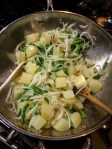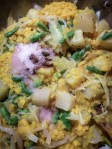Jump to Recipe This dish is creamy, flavorful, and colorful – a great fall comfort food. It’s easy to adapt with different vegetables and varying the spice to match your taste. If you’re not familiar with dhal (or dal), think of it as a cross between pea soup and stew without any meat (you should also try this coconut dhal recipe!)
I’ve served it as a side-dish with meat or as a main dish. It has a few steps to make sure it comes together with the right textures, but the first two are pretty simple so it isn’t as complicated as the instructions might look. If you don’t mind using a microwave, you can do that for the potatoes to speed it up a bit.
Pre-cooking the dhal and potatoes separately does use a few extra dishes, but it also makes it easier to multiply this dish than many other ones that use slow-cooking ingredients. I’ve doubled the recipe in the photos below./
 Finding the right kind of lentils may be difficult in areas without access to Indian groceries – while the texture is similar to split peas, the thinness of masoor dal lets them cook more quickly than the green split peas I’ve grown up eating in soups. If you want to try it without Indian dhal/dal, you could try yellow split peas but I would cook them in a slow-cooker much longer to get the right texture.
Finding the right kind of lentils may be difficult in areas without access to Indian groceries – while the texture is similar to split peas, the thinness of masoor dal lets them cook more quickly than the green split peas I’ve grown up eating in soups. If you want to try it without Indian dhal/dal, you could try yellow split peas but I would cook them in a slow-cooker much longer to get the right texture.
I don’t know much about the history of this dish and googling found several similar versions – if anyone who knows it better would like to tell me more or share their favorite tweaks, I’d love to learn more!

Madras Sambal
A creamy, lightly seasoned veggie curry that is rich and filling.
Ingredients
- 1 cup / 8 oz. masoor or tuvar dhal
- 2 1/2 cups water
- 1/2 tsp. ground turmeric
- 2 large potatoes, cut into 1″ chunks
- 2 Tbsp. oil
- 1/2 tsp. black mustard seeds (use yellow if you can’t find these, but the color is less fun)
- 1/4 tsp. fenugreek seeds
- 4 curry leaves (these are not the same as bay leaves)
- 1 onion, thinly sliced
- 4 oz. green beans, cut into 1″ chunks (or other quick-cooking veggies like zucchini will work too)
- 1 tsp. salt
- 1/2 tsp. pepper
- 1 Tbsp. lemon juice garnishes: toasted coconut, coriander chutney (a bright green cilantro sauce! yum!)
Directions
- Start by rinsing the dhal several times – you will see the water get cloudy and little bits of the bean skins float to the surface. I usually do this in a deeper pan so I can stir with my hand and get it all out quickly. Using a mesh strainer to make sure none of the thin beans slip out with the water can help.
- Add the measured water to the dhal after you’ve drained out the rinsing water and stir in the turmeric. Cook over medium heat until it comes to a boil, then lower the heat and simmer for 30-35 minutes or until it’s soft and most of the water is absorbed.
- Par-boil or microwave the potatoes to make sure they’ll cook evenly later – you don’t want your lighter veggies to get overcooked. You could do the same thing for any other heavy root veggies you want to add. This will take about 10 minutes for potatoes in boiling water, less for the microwave but check after a few minutes to make sure they don’t get soft.
- While the dhal and potatoes cook, prep your other ingredients. You’ll want to have the spices measured and the veggies trimmed so you don’t risk burning anything that cooks faster. Heat the oil in a large frying pan or wok over low heat with the spices and curry leaves, about 2-3 minutes or until the mustard seeds start to pop. Watch out that you don’t scorch the fenugreek seeds, though!
- Add the onion and green beans or other raw veggies that cook quickly. If you’re using frozen beans, wait until the onions are softened before adding so they don’t overcook. The onions will take about 7-8 minutes to soften, usually.
- Add in the potatoes and cook another 2 minutes, stirring well to coat them in all the seasonings.
- Drain off excess water from the dhal and stir it in with the salt, chili powder, and lemon juice. Adjust seasonings to taste.
- Garnish with toasted coconut and serve with coriander chutney (optional – clearly a step I skipped in these photos).











Delicious and comfort meal Indeed! Thanks for sharing.